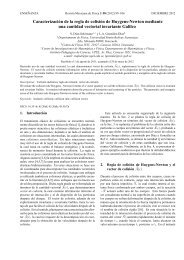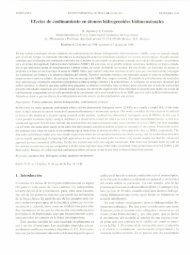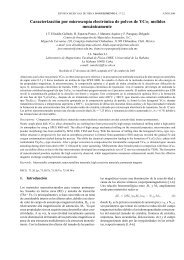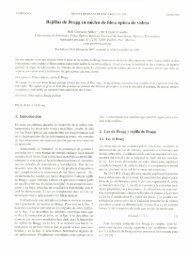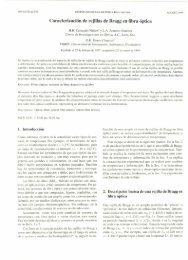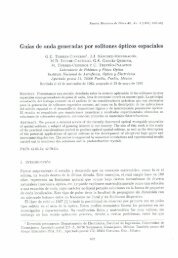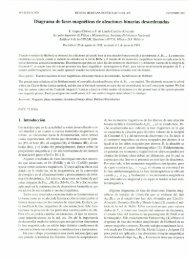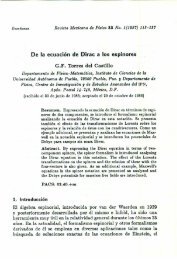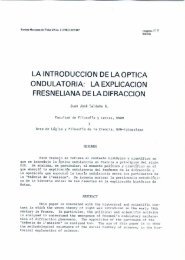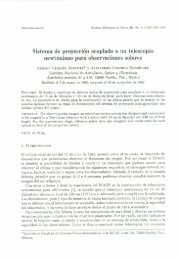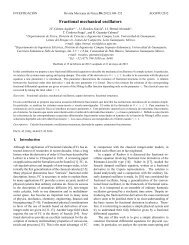You also want an ePaper? Increase the reach of your titles
YUMPU automatically turns print PDFs into web optimized ePapers that Google loves.
<strong>Revista</strong> <strong>Mexicana</strong> <strong>de</strong> Física 43, No. 5 {1997} 673-698<br />
Atoms as QED bound atoms<br />
R. .JAUREGUI, C.F. I3UNGE, AND E. LEY-Koo<br />
Instituto <strong>de</strong> Física, Universidad Nacional Autónoma <strong>de</strong> México<br />
Apodado postal 20-.164, 01000 México, Mexico.<br />
Recibido el 10 <strong>de</strong> febrero <strong>de</strong> 1997; aceptado el 20 <strong>de</strong> marzo <strong>de</strong> 1997<br />
ABSTRACT. The relevanee of Quantum Electrodynamics (QED) in contemporary atomic structure<br />
tlwory is re\'iewed, Recent experimental advances aIlo\\" hoth the produetion of heavy ion s of<br />
high charge as well as the mea..'iurement of atomic properties ,vith a precision ne"er achieved<br />
hefore. The <strong>de</strong>scription of hea"y atom~ with few electrons "ia the successive incorporation of<br />
one, two, etcetera photons in a rigorotls manller ami within the hound sta te Furry representation<br />
of QED is techllically feasible. For many-elf'ctron atoms the many-body (correlation) effects are<br />
very importallt and it is practically ilIlpossihle to evaluate aH the relevant Feynman diagrams<br />
to the required accuracy. Thus, it. is Ilecessary to <strong>de</strong>vf'lop a thporetical scheme in which the<br />
radiative and nonradiativc effccts are takeIl iuto account in an effedive way making emphasis<br />
in e1ectrollic correlation. Preserving gaugc invariallce, ami avoidinp; ooth contilluum dissolution<br />
and variational collapse are basic problelll~ that IllllSt. be solved when nsing effective potential<br />
methods a.ml finite-basis represcntatioIls of t.hem. In this context, we shall discuss advallces and<br />
prohlems in the <strong>de</strong>scription of atollls as QED iJolltlcl stat.es.<br />
RESUMEN. Sc hace lIna revisión
674 R. JAUREGUI ET AL.<br />
inspired and motivated by the measnrements of one fnndamental property of ¡he electron<br />
ami two atomic properties: the free-electron gyromagnetic factor .'le [2]' the Lamb<br />
shift [3] and the hyperfine structure in hydrogen [4). Even nowadays, the excellent<br />
agrecmcnt between experimental alld thcoretical evaluatiollR of t}¡cse qllantities constitutes<br />
a fundamental test of the validity of QED. However, there are important differences<br />
in the difficulties related to the evaluation and measnrement of QED effects when<br />
going from free electrons into atomic hound electrons. On the one hand, the unprece<strong>de</strong>nted<br />
experimental accuraey achieved in the measurement of the free eleetron ge-factor,<br />
!le = 2(1 + ae) with ae = (1159652188.4:!: 4.3) X 10- 12 [5]lIlay he colllpared with the<br />
1Il0st accnrate rigorous calculation performed within any quantulll field theory framework,<br />
ac = (1 159652208 :!:52) x 10- 12 [6]. Correetions up to the fonr photon level were<br />
indu<strong>de</strong>d in this theoretica1 calculation and its accuracy is at present lilllited by the uncertainty<br />
in the fine structure constant n. This constant measures the electron coupling<br />
to the electromagnetic field and is the only physical para meter which lIlust unavoidably<br />
he introduced in the calculation. On the other hand, for atomic systellls there are several<br />
relevant physical parameters:<br />
o n which <strong>de</strong>termines the strenght of the interaction hetween electrons ¡¡B well as<br />
their selfinteraction .<br />
• Zn: which conditions likewise the intcraction betwecn the electroll and thc nucleus.<br />
It also <strong>de</strong>termines indirectly the velocity of the electrons.<br />
o N, the number of e¡ectrons in the system .<br />
• 711 e/Al 1l1 the ratio of the electroll ami nuclear Illasses llsed 111tlle characterization<br />
of the center of mass system.<br />
o A, the number of nueleons. It sets the nu<strong>de</strong>ar radius aIl
ATmlS AS QED BOUND ATm1S 675<br />
In this work we shall make a brief review of advances achieved by several theoretical<br />
groups in the la.st <strong>de</strong>ca<strong>de</strong> to incorporate QED e!fects in atomic systems. These e!fects<br />
inclu<strong>de</strong> both radiative and correlation properties <strong>de</strong>rived from the quantum nature of the<br />
electromagnetic and electron flelds. The relevance of radiative corrections is particularly<br />
important for high-Z few-electron ions. In the next Section, we shall mention some of<br />
the experimental teclllliques presently used. Next, we shall hriefly <strong>de</strong>scribe the boundclectron<br />
QED formalism and how it has been used to obtain numerieal predictions for<br />
one- and two-electron ions. Then, we shall outline feasible approximation schemes to<br />
aeeuratcly <strong>de</strong>scrihe high-Z many-electron atoms. For these systems, the main radiative<br />
correetions can be evaluated by similar teclmiques to those used for few-eleetron atoms.<br />
So that, nowadays, the relativistic correlation problem is consi<strong>de</strong>red the bottleneek to he<br />
overcome. The kind of prohlems that have to be sol ved and the ways used to eircumvent<br />
them will be <strong>de</strong>scribed. In particular, the results achieved by our grou!, will he briefly<br />
presented in three seetions at the end.<br />
2. 50ME EXPERIMENTAL TECHNIQUES TO OIlTAIN HIGH Z FEW-ELECTRON IONS<br />
Highly charged, high-Z ions can be obtained in several ways. Tokamaks and high-power<br />
laser- produeed plasmas may yield, e.9., niekel-like uranium, U 64+ At present, higher<br />
charge states are studied basically by two techniques:<br />
(a) I3eam-foil or beam-gas techniques: After being accelerated at large velocities (velocities<br />
comparable to those of the J( electron of the project.ile to optimize ionization)<br />
low-charge ions are sent into light targets where they can be fully stripped. Then<br />
the ious go ¡uto a. thinner "dressing" targct w hefe thcy capt ure few elcctrolls gCIlerally<br />
in exeited states [7-11]. The photons emitted in flight by the ions are then<br />
observed with a <strong>de</strong>tector in the laboratory frame. The Doppler e!fect limits the<br />
accuracy of the data thus obtained lIlainly due to the uncertainty of the observation<br />
'Ingle. The most accurate reported spectroscopic data nsing this technique correspond<br />
to the measurement<br />
uraniulll [11l. It reqnired<br />
of the<br />
cooling<br />
Lambshift of the ground-state of hydrogenlike<br />
the ions by electron beams and observing the<br />
radiativc rccOIuhinatioll X-rays al an anglc of almost 00.<br />
(b) Electron-beam ion trap: Trapped ions injected in low-charge states or as neutral<br />
vapors are ionized to high-charge states by successive collisions with beam electrons<br />
[12). I3ecause collisions with the electron beam results in a heating of the<br />
ions, light-ion cooling may be used to prevent <strong>de</strong>trapping of heavy ions. Notice<br />
that electron-beam ion traps nse the inverse of the accelerator based beam-foil or<br />
b"am-gas technique. Instead of a stationary electron target interacting with relativistic<br />
ions, the ious in the trap fonn an almost stationary target interactiug<br />
with a relativistic electron beam. The aecuracy is lilllited just by the counting<br />
statistics (13]. In this way it ha.. "i bcell possible to IIlca.....<br />
mre, C.g., the two-clectroIl<br />
contributions to the ground state of heliumlike Ge, Xc, W, Os and I3i [14), and<br />
iOllizatioIl cro~~-scctioIlSof hcliumlike U 9C J+ and hydrogclllike U91+ [13J.<br />
In the ncar futurc, thcse techlliqucs will makc it possibJe to obtaill IlOt oIlIy more<br />
aCCllrate IIlC;:L"illremellts01'atomic strueture of very Itighly charged ious! hut also to stlldy<br />
atomic dynamics in the higlt-Z regimc.
676 R. ,JAUREGU¡ ET AL.<br />
3. QED PERTURBATION THEORY IN THE BOUND INTERACTION PICTURE<br />
In the eighties, Mohr proposed (15) to reconsi<strong>de</strong>r atomic systcrIls in au uIlllslIal way. As<br />
a first approxirnation, the atorn would be regar<strong>de</strong>d as él sct al' non-interacting Dirac electrons<br />
and an infinitely heavy nueleus. The main roles of t.he nueleus would be 1.0 provi<strong>de</strong><br />
an external potential allowing atom fonnation and 1.0 <strong>de</strong>fine a privileged frame of reference<br />
[ol' <strong>de</strong>scribing the systern. Radiative corrcctiolls and eledron-eleetron intcractioIlS<br />
would be regar<strong>de</strong>d as more or less important perturbations produced by interactions of<br />
the electrons with the quantized electromagnetic field. The QED perturbation theory<br />
built from t.he basis states of non-int.eracting Dirac electrom bound in the static field of<br />
the nuelens [15,16] is called bound elec!.ron QED. Naturally, these i<strong>de</strong>as are particularly<br />
useful for <strong>de</strong>scribing high-Z few-electron ions.<br />
Let us go over t.he essent!al features of this formalismo The zero-t.h or<strong>de</strong>r basis states<br />
are eigenfunctions of the Dirae equation<br />
for an external pot.ent.ial which in t.he simplest case is t.aken as t.he Coulomb pot.ent.ial<br />
generated by a point source<br />
Ze 2<br />
V(:i') = --I~I.<br />
,.<br />
Undcr these conditions 'ljJn is analitically knowIl both fOf bOllnd and cOlltil1lll11Il statcs<br />
ami t.here is a elosed express ion for E". When alternat.ive not. exactly solvable expressions<br />
of t.he local potential V(:i') are used it is necessary 1.0 compute numerically the functions<br />
,p".¡ The clectron-posit.ron field operat.or .¡, is expan<strong>de</strong>d in t.enns of the annihilation ami<br />
creatioIl operators,<br />
with the usual anticonmutation rules<br />
The elec!.ronic vacuum is then <strong>de</strong>fined as<br />
- - -t -t<br />
{h",I",,} = {hn-hn,} = O.<br />
án 10) = hn lO) = O.<br />
The bound-state Green function S F is given by,<br />
S¡.-(X2,X¡) = \OI'f[ijí(:I:2);I;(1'¡)] lo)<br />
with f the time-or<strong>de</strong>riug operator.<br />
1 1'= "" 1/Jn(:C2)1jj,,(:I'¡)<br />
= - dz L- ---~~--<br />
27ri _= E" - z( 1 + úl)<br />
, 11<br />
1In fact, at prescnt, numerical co<strong>de</strong>s are wriUen in ~Il(,}¡a \vay that eVf'H in the ca.se of kn()wnin~ {0n}<br />
anal,yticall,y it. i:"more convinÍcnt lo work with it.:"Illlllll'rical rCJlre~('nt.at.ioll:",<br />
(1)<br />
(2)<br />
(:1)<br />
(4)<br />
(5)<br />
(5)<br />
(7)<br />
(8)
ATmlS AS QED SOUND ATOMS 677<br />
In an analogous way, one starts frOln the quantized free clectromagnetic field:<br />
A' - '" e!'[c' N e'kvx v + ¿:t N e-. kvxV ]<br />
~- L. ~ k!. k kA k .<br />
k!.<br />
Here e~ <strong>de</strong>notes the nnitary polarization vectors and Nk the normalization factor of the<br />
kv clectromagnetic mo<strong>de</strong>. The usual commntation rclations arc imposed on the operators<br />
i:k).., that is<br />
The free electromagnctic vacuum is dcfined as<br />
Thus, the Feynman gauge photon propagator D F is given by<br />
(9)<br />
{' , } {'t ,t } O<br />
Ck>",Ck')..' = ck),'c k ,).., = . ( lO)<br />
g,w DP( X 2, x¡) = EM (oifl4,,(:r2)Av(x¡)] [O) CM<br />
As usuaI.thc noninteracting ficld Hamiltonian <strong>de</strong>nsity Ha is <strong>de</strong>fined<br />
or<strong>de</strong>rcd operator<br />
Ha =Ho + HgM Ho = : ilít(x)¡,ilí(x) :<br />
H EM __ 1_ . F (x)F'W(".).<br />
o - 16,,' ~v •. .<br />
(11 )<br />
( 12)<br />
( I:J)<br />
by the normal<br />
while the Hamiltonian dcnsity for the interaction bctween the e!ectron-positron field and<br />
thc radiation ficld is<br />
(14)<br />
(1S)<br />
( 16)<br />
H¡(x) =: l,.(x)A" (x) : (17)<br />
with j" = e1J!(xh~ilí(x) the e1ectron-positron cnrrent. In the bound state interaction<br />
picture the state vector wavefllllctioll evolves according lo<br />
wherea... , allY opcrator F evolves according lo thc equation<br />
D-<br />
-in Dt F = [ifa, F(t)j.<br />
The evolntion operator fJ(t, to) satisfies the "quation<br />
H ~ - eiJíot H~e-iifot<br />
¡ST - 1 , ( 1~)<br />
( 19)<br />
(20)
678 R. JAUREGUI ET AL.<br />
Now, one of the pnrposes of bound electron (lED is the calculation of tbe ener¡!;y sbifts<br />
due to the interelectronic interaetion. This interaction is present aU the time. Thus. in<br />
or<strong>de</strong>r to apply the usual scattering techniques of standard (lED, GeU-Mann and Low [17]<br />
introdueed the adiabatic Hamiltonian<br />
lim ')'(1.) = O.<br />
t-+.:!:oo<br />
Usual QED is applied and at tbe end of the calculations tbe limit ')' -+ O is taken. The<br />
energy shift due to the iuteraction of a state 11I~}with tbe Cjuantized ¡¡eld is then given<br />
by the GeU-Mann and Low expression<br />
hE l' . (a/ae)N~IDo(r), -oo)l
(e)<br />
o ('<br />
S ;;<br />
= ..=OJ =<br />
(1)<br />
'.<br />
=-~=<br />
(a)<br />
-.-.=.---<br />
\<br />
(0<br />
=-=-=-.-.-<br />
(d)<br />
=.=<br />
I\J)<br />
c~<br />
( ,<br />
;;<br />
(g)<br />
(k)<br />
ATmlS AS QED BOUND ATOMS 679<br />
=.==~<br />
(b)<br />
(j)<br />
..-.~-<br />
(e)<br />
~~~~=<br />
(h)<br />
FIGURE l. One-phototl and two-photon Feynman diagralJl~ COI'onc-electroll atoms in the bound<br />
forlllalislll of QED. The one-photon diagrallls are (a) lhe self-energy (SE), ami (b) the vacuulll<br />
polarizatioll (VI') diagrallls. The two-photon diagrallls are: self-energy-self-energy (SESE) [diagrallls<br />
(e)-(e»), vacuulll polarization-vaeuulll polarizatioll (VI'VP) [diagrallls (f)-(h)], self-euergyvaeuulll<br />
polarization (SEVI') [diagrams (i)-(j)], and self-vaeuulll-polarization-energy [S(VP)E]<br />
[diagralll (k)J.<br />
propagators which can be treated analytieally so that the divergenees are isolated and<br />
substraeted using standard QED teehniques. In faet the many-potential part of the SE<br />
diagram is free frolll divergences allowing its difect cvalllatioll llsillg tcchniqllcs such as IlUmerieal<br />
ba"is-set approaehes. This has ma<strong>de</strong> it possible to inehule realistie nuclear eharge<br />
distributions sueh as two-parameter Ferrni and <strong>de</strong>formed Fenni mo<strong>de</strong>l distributions in the<br />
ealeulation. An alternative to evalnate the SE correetion was renmtly proposed [23,24].<br />
It cOllsists iu <strong>de</strong>composillg both the unrenormalized hOllud-statc SE and ma... "iS term iuto<br />
(livergcllt SlIlllS over finitc partial-wavc cOlltriblltiollS. Thc rellorJllalizatioll sllbstraction<br />
is thcn performcd al thc partial-wave level alld a couvergellt rCllormalizcd boulld-state<br />
SE is ohtainc
680 R. .JAlJltEGlJlET AL.<br />
coordinatc spacc is<br />
v = _ C.<br />
(26)<br />
I U<br />
Z 100 d= (2 ~)<br />
3 - + -2<br />
" o=:=:<br />
V=.2- I J ¡.J.. (.~) exp( -2mr='lt<br />
-2 ( .1.(' .l. - -<br />
Ir - xl<br />
- il)<br />
,<br />
with p(i) the nu<strong>de</strong>ar eharge <strong>de</strong>nsit.y. Explieit evaiuat.ions of Íts cont.ribut.ion to the<br />
energy eorreetion can be found in He!".28. The Widnnann-Kroll eorreetion evaluated to<br />
all or<strong>de</strong>rs in Z" by Soff and Mohr [29] gives a eorreetion to the energy of the form<br />
t::.EII"f{<br />
" (aZ)4 ,<br />
= ---.J-H("Z).<br />
(27)<br />
" n<br />
State <strong>de</strong>pen<strong>de</strong>nt values of the funet.ion fl(aZ) are t.abulat.ed in Ref. 29 using a spherieal<br />
shell distribut.ion for the nu<strong>de</strong>us.<br />
The two-phot.on QED effeet.s [3D) are classified ,1.' sell~elJergy-self-energy (SESE) [diagrams<br />
(e)-(e) of Fil'. 1), vaeuum polari"ation-vaell1ml polarization (VPVP) [diagrams<br />
(f)-(h) of Fig. 1), self-energy-vaeuum polarization (SEVP) [diagrams (i)-(j) of Fil'. 1)<br />
and self-vaeuum-polarization-energy [S(VP)EI [diagram (k) nf Fig. 1]. These eorreet.ions<br />
represellt scparatcly gauge iuvariant sets. Ahllost aH nf thclIl have becll rcccntly evaiuat.ed<br />
for H-like uranium whieh 11:1., beco me the standard t.est. case nf QED in one-eleetron<br />
ions. For this ion, t.he VPVP diagram (l") has been evalualed by Persson el al. [31,32]<br />
and the VPVP diagrams (g,h) known ,1.' Kiillén- Sabry con!.ributions were compuled by<br />
Beier and So!!"[:1:1] and by Sehnei<strong>de</strong>r el al. [34] in Ihe Udlling approximat.ion. The SEVP<br />
correetions can be found in Re!".31 while !.he S(VP)E correetion in the Uehiing approximal<br />
ion has been reported in Re!". 32. The SESE shift eorrect.ion. Taking into aeconnt aH e!feets<br />
<strong>de</strong>scribed in this sect.ion, t.he t.heorct.ical Lamb ,hin. o!"Il-like uraninm gives [:1O] t.he valne<br />
465.5:t2 eV wit.h t.he main nneertaint.y arising from t.he SESE diagrams that have not. !>een<br />
ealenlated yet. The latest reported experiment.al valne [111 is 470:t 16 eVo Su!>st.ant.ial<br />
experimental adval1ces have beeu achieved lat.ely so tita!' important improvclIlents in the<br />
aCCllracy are expeetcd.<br />
G. TWO-ELECTlWN HlGH-Z IONS.<br />
Tbe FeYllman diaJ..';rams rOl' the first-orc1"r expansioll nmsist (jf t.hc OIlC-f~xdlallged photon<br />
C()ITC'ctiOIl, SE allll VP. Thcy aw showll in Fig. 2. \Vit.hill this formalislIl. the SE alld VP<br />
rOl' the two <strong>de</strong>ctroll at.olll are jllst ('qllal t.o t.he (,OlT(,spolI
--'= ... =<br />
(a)<br />
(( J)<br />
?<br />
===::==- •.= ===<br />
(b)<br />
ATO~lS AS QED BOUND ATO~lS 681<br />
¡<br />
===== •.=====~<br />
FIGUHE 2. For two-plectroll atoIl1s. tiJe FeYlllllan diag:rams rOl' the first-or<strong>de</strong>r Iwrturhative ('xpansioIl<br />
in lhe bound formalism of QED are: (a) the one-exchanged pbotoll diagram, (h) lhe SE<br />
diagram and (e) ¡he VI' diagram.<br />
Tite onc-exchallgcd-photoll corrcctioll lo thc ellcrgy call be written [15J as a dircct<br />
term \vhich is real:<br />
E - ,2/ ¡'l. f ¡3 ",1(- ,-) 1 (2) 1'(1)."(,-,, .-)<br />
ti - L (X2 (Xl!' X2~.r:l 1'-: "7 IO,t n: '!' .1'¿,XI 1<br />
• .1''2 -1'1<br />
and aH cxchallge term which is complcx:<br />
with<br />
TI = [E¡n - EO,)/I"<br />
Thc imaginary part of thc cxchangc t.erm correspollds lo a partial width contriblltion 1.0<br />
the excitcd-state rcsonallcc associatcd to t}¡e
682 Il. .JAUREGUI ET AL.<br />
1<br />
~. (a)<br />
(e)<br />
~~<br />
=~=.--.-<br />
S<br />
(el<br />
~;~~.=======<br />
(b)<br />
(di<br />
~. ~_.~<br />
FIGURE 3. The two-photon ('ontrihutions to thc electron-clcctroll interaction of two-clectron<br />
atoms are: tile correlatioIls diagrams (a) laddcr, ami (b) crosscd-photon; the two-elertron Lamb<br />
shift diagr:uns of VP. diagrams (e) and (d). aud of SE. diagrams (e) and (f).<br />
Lamb ,hift, i.e., vaeuum polarization, (e) aud (,1) in Fig. :1. and self energy, (e) and (f)<br />
in Fig. 3, have been direet1y ealculated by Pers,on et al. [41J using a finite nu<strong>de</strong>ns ami<br />
a nnifol"ln charge distribution. To a first approximation, (e) aud (f) can be regar<strong>de</strong>d as<br />
a screening of the single-eleetron Lamb shift whieh can be estimated by modifying the<br />
nuclear potentia1 [23,42, 43J.<br />
Experimentally, the ionization energy of heliumlike ions has been eompared with<br />
that of hydrogenlike ions. This has allowed to measure the two-eleetron contribution~<br />
to the grollnd state of He-1ike ions. However, the estimated theoretica1 IIncertainty is<br />
:1:0.1eY [41]' mlleh lower than the reported experimental olle which ranges from :1:1.6eY<br />
for Ce (2 = 32) to :1:14eY [or l3i [14J.<br />
G. l'vIANY-ELECTRON ATOMS.<br />
\Vhell <strong>de</strong>aling with l110re than two-electrOlI atoIlls it hecomes very complicated lo treat<br />
the systclll by evaluating mW l two, ... , dc. photan diagrams in a successive way. At<br />
lcast two alternatives have becn explored.<br />
The first one [44-46] corresponds to IIsing effective one-parti<strong>de</strong> local potentia1s Vol! in<br />
terms of whieh the Furry representation is worked out. These modd potential, try to take<br />
approximately into account the interactiull between clectrolls in atoms. In the simplest<br />
cases they are taken as central potentials inféred from Hartrcc-Fock calc1l1ations. The<br />
(1)
ATOMS AS QED BOUND ATOMS 683<br />
S-matrix approach <strong>de</strong>scribed in Sect. 3, is constructed and three different type of diagrams<br />
can be consi<strong>de</strong>red. The first elass corresponds to photon exchange diagrams which<br />
may be connected with many-body perturbation theary (MBPT) diagrams. The second<br />
corresponds to pure radiative correction diagrams and the third to radiative-correlation<br />
diagrallls. This elassification of diagrams has already been illustrated for two electron<br />
atoms in Fig. 3. The difference is that the electron legs and electron Creen fllnctions<br />
consi<strong>de</strong>red here inelu<strong>de</strong> the effects of the effective local potential U pff . In general, radiative<br />
QED corrections are dominated by the one-electron Lalllb shift [45). These SE amI<br />
YP corrections are evaluated llsing the techniques mentioned in Seet. 4 far hydrogellic<br />
ions but consi<strong>de</strong>ring the screening effect contained in Udf(r) [46]. Thus, the third elass<br />
of radiative-correlation diagrams is expected to give a slllall contriblltion whenever the<br />
local potential Ueff(r) gives a good 7.eroth-or<strong>de</strong>r approxilllation to the eleetron-electron<br />
interaction. In principIe the problelll is basically reduced to evaluate the correlation<br />
diagrallls via MBPT. However, as we shall see below, besi<strong>de</strong>s possible convergence problems,<br />
relativistic many-body perturbation theory (RMBPT) has peculiarities of its own<br />
requirillg more than a simple cxtensioll of its nonrelativistic counterpart.<br />
A second alternative is to <strong>de</strong>fine an N-electron Hamiltonian [40,47].<br />
N<br />
H = L hn(n)<br />
N<br />
+ L \~nn+<br />
N<br />
L Vmnp+ ...<br />
n:::=1 m
684 R. .JAUREGUI ET AL.<br />
cOllditiolled by the method of solvillg the N-particle problem. Allother example of this<br />
problem corrcsponds to thc use of thc timc-retar<strong>de</strong>d I3reit interactioll. Illcntioncd in<br />
Section 5, beyolld first or<strong>de</strong>r MI3PT. Such a procedure is 1101. mealliugful unless virtualpair<br />
effeds are eonsi<strong>de</strong>red also [40].<br />
7. THE RELATIVISTIC MANY-1l0DY PROIlLEM.<br />
Once a relativistic lually-hody Hamiltoniall ha.. 'i bCCIlobtaillcd (1.. '; an cver approxiInate<br />
reprc.scntatioll of the atolll1 it is Ilcccssary to find a IllIIllcrical schcme to work it. uut. In<br />
the bcgiuuillg, it was expcctcd that a direct gCIlcralizatioIl of the approximatioll Illcthods<br />
of the nonrelativistie mally-boc\y problem eould be used. Usual lIonrelativistie af¡ i1litio<br />
meI.hods are essentially of two types:<br />
• The lIartrcc-Fock approximatioll obtaincd vía eit}¡cr a Jlulllcrical solution nr a hasis<br />
.set approxiluatioll .<br />
• I3eyolld Hartree-Fock vía either a perturiJativc approach ar a variational approach,<br />
the latter supported by a variatiollal theorem.<br />
In the late sixtics and across thc sev{mtics. great cfforts \'lerc <strong>de</strong>vokd lo thc sollltiOll of<br />
t.hc Hartrec-Fock eqllat.ious which rcsult frolll considcriuf!; t,hc Hallliltonian of LIJe fonu<br />
(:J4) with a t.wo-body potelltial collt.aillillg 1.1", COlllomh illteraetioll.<br />
S IV 2<br />
e<br />
He = ¿hD(n) + ¿ 1.<br />
aud 1 sOInetimcs, lluretar<strong>de</strong>d l3rcit interactioIl.<br />
1t=1 '''henomCllft is not sllrprising<br />
due to the fad. that, in gcncral1 Dirae lIamiltollialls admit a cOlltinllUIII 01'ncgative-ellcrgy<br />
cigenstates so t.hat their spectra an~ not boulldt'd from \H'low. Thlls. the applicahility ol'<br />
the usual qllalltulI1 mechallicaI varial.ional t.1H'orem is uol. direct. Ilo\",.cver. variational<br />
collapsc aIso arises bccal1se finite-ha ....• is represclltatious of Dirac-like Hamilt.ollialls do<br />
BOÍ- always reproduce essclltia.l qllalit.ies oi' tlw original opcrator. lu ordcr to illllstrat.e<br />
tIJis point1 let us remcmber that the cigellvahw cqllatioll 1'01'CVCIla olle-pa.rticle Dirac<br />
,<br />
(:)4)
A'rmls AS QED BOUND ATO~lS 685<br />
Hami1tonian hD is a system of coupled equations for the so called "small" and "Iarge"<br />
components. Thus, in or<strong>de</strong>r to be reliable, a finite-basis representation of h o rnust allow<br />
the possibility of approxirnately representinp; such a coupling [57,58).<br />
Now, the implclnentation of nonrelativistic many-hody perturbatioll techlliqlles to<br />
Dirac Harniltonians is not straip;htfoward either. As first reported by Brown amI Ravenhall<br />
[59), a conventional perturbative ealculation should start from a complete set of eigenfUllctions<br />
of a zeroth-ordcr Dirac Hami1tonian Ho. This complete set inclu<strong>de</strong>s Ilcg:ativcenergy<br />
states. Second- and higher-or<strong>de</strong>r pertnrbative corrections would rnake such states<br />
to appear as virtual electron-positron pairs which, howcver, are Bot cxperimelltal1y ohserved.<br />
Mathematically, it is not possible 1,0 apply naively standard perturbation theory<br />
because the spectrum of a systern of N noninteracting electrons will exhibit an infinite<br />
or<strong>de</strong>r <strong>de</strong>generacy due to the presence of ti", negative energy continuum in the spectrum<br />
of each individual eleetron. This effect is known a.S c0711i71uu1T!dissolulioTl. Brown ami<br />
Ravenhall condu<strong>de</strong> from this that the use of an N-parti<strong>de</strong> Hami1tonian is rneaninp;-<br />
Icss sincc starting froIn a noninteracting N -clcctroll Hamiltonian "by turning 011 slowly<br />
the elcctron-electron interactioll thc systclIl can make real transitions to statcs whefe<br />
one electron ha.., a Iarge negative enerp;y and the other eleetron is in the positive-energy<br />
cOlltiuuUIll. ll<br />
In or<strong>de</strong>r to give a eomputational scheme which allowed the use of MBPT techniques<br />
an approach knowII a.', no-(virtual)-pair apPT"(Jximation was proposed [60]. It cOlIsists in<br />
replaeing the N -partidc mo<strong>de</strong>! Hamiltonian HO by its projeeted counterpart<br />
where 1\+ is thc projectioll opcrator constrllcted a.''; tlw product of oue-particlc positive<br />
PIlcrgy prajection operators dctcrmined by a aue particle Hami1tollian h o . Thc use of<br />
sueh projeetion operators wa..sfonnalIy proposed hy Brown aud RavenhalI who iu fact<br />
chose 11.0 'LSthe free-particIe Dirac-Hamiltonian. Later Sucher [(j2) advocated the use of<br />
sllch projectors, howcvcr Ilumcrical reslllts OIl the hydrogcn af,om [63] led to very bad<br />
estimates of the speetra showinp; its inapplicability. Thus, H¡;/> is hip;hly <strong>de</strong>pen<strong>de</strong>nt on<br />
the one-parti<strong>de</strong> Hamiltonian ho used 1,0 <strong>de</strong>fine A+ [(j1J. The important point is that the<br />
<strong>de</strong>finition of one-parti<strong>de</strong> positive states <strong>de</strong>pends on the l!amiltonian 2<br />
A<strong>de</strong>quate projeetion operators, A+, discriminating between (+) amI (-) sta tes were<br />
proposed by a number of authors [45,61, (j5). In particular, the A+ whieh makes ti",<br />
energy stationary whcn tite wavc function is a single <strong>de</strong>terminallt. t.urns out t.o be lH'pcise1y<br />
the projeetion into DHF orbitals [65). When workinp; with a Hamiltonian with the<br />
structnre of Ec¡. (34) with two-body interactions, takinp; the OI"'-particIe l!ami1tonian h o<br />
as hD gllarantces that thc no-pair approximatio!l is corred to ordcr 0(0'2) [noJ. Howc\"cr.<br />
cvcn with this choice, attcmpts f.oobtain explieit expressiolls rOl" A+ havc becll stcrile [titi].<br />
Meanwhile, people have resorted to lIe,.y larye ba..sissets from whieh a partition into (+)<br />
and (-) sta tes is ma<strong>de</strong>. A most sllecessfll! scheme to construet (+) one-particIe sta tes<br />
JIn other arca..;;of ph)"sics surh a.•. quanttllll theor.y in tlll' prf:'S(,IlCf'<br />
of ¡:!,rayitational fil'lds or fjllantllfll<br />
Ollt.ics tlH~ <strong>de</strong>IH'u<strong>de</strong>nce of the positi\"{'- and ucgatiye-stat('s <strong>de</strong>filliliou UII the wan'-equat.ioll ha.." "(,I'1l<br />
latel)" exploited. In particular t.he Bogolllbo\' formillislIl p('nnit~ to qllalltif\ th" mixing (lf positin>- aud<br />
IH'gativ('-statf'~ for diff('rent wave-eqlliltiolls with ('qual houlldary nlllditiollS [64].
686 R. .JAUREGUI ET AL.<br />
was proposed by .Johnson et al. [67] whereby ha = h[) is placed in a cavity of radius<br />
R '" 40 a.u., viz., surroun<strong>de</strong>d by an infinite potcntial barrier at r = R; also, each largc<br />
compollcnt is reqllired to be equal to its partner sIIlall componcllt at r = R in ar<strong>de</strong>r<br />
to avoid Klein's paradox. The basis sets are B-splines [(;8]. Usiug MBPT based on the<br />
projected Hallliltonian HfjP constructed iu this way has ¡ed to quite precise estimates<br />
for the lowest energies of some many-electl'Ou ions [45,69-71).<br />
For systems where high-or<strong>de</strong>r MBPT contributions are not negligible,<br />
C.g. most neutral atoms, alternativc schclIlcs 1I1118tbe llsed lo take iuto arCollnt<br />
correlation in an accurate way. AlIlong them there is the coupled cluster (CC) approach<br />
which lcads to aH-or<strong>de</strong>r equations that "1'011 iteration yield or<strong>de</strong>r-by-or<strong>de</strong>r expressions<br />
for tbe Rayleigh-Schr6dinger linked-diagram expansioll [72]. Its reliable implementation<br />
for relativistic many-body systems is a chaHenging problem to wbich several gronps are<br />
<strong>de</strong>voted amI some applications bave appeared lately [73].<br />
Two other promising alternatives are the configllration interaction (CI) [7(; -81] amI<br />
tbe multiconfigurational Oirac-Hartree-Fock (MCOF) [74,75] approaches. Tbey are variational<br />
techni,,"es which go beyond the ill<strong>de</strong>pen<strong>de</strong>nt particle 1Il0<strong>de</strong>l. Lacking a variational<br />
theorem that can be directly applied to the N-parti<strong>de</strong> Oirac eqllation, the reliability of<br />
these approac}¡cs is Bot clcar in ~cncral. 111fact, whether the use of projectioll opcrators<br />
is ncccssary or 110t in the MCDF case ha..o.; been controversia1 [74]. In the next SCctiOIl1 we<br />
shall present a version of the variational theorcm which. withill thc el SCheJIlC.ovcrcolIlcs<br />
varia.tiollal collapsc and contill11111Il dissollltioll. alld yields uppcr hOllUds to the cnergies<br />
obtaincd with projcction opcrators in<strong>de</strong>pclldcntly of "he ouc-parti<strong>de</strong> Hamilt.ollian tlsed<br />
to <strong>de</strong>fine them [81].<br />
8. A VARIATIONAL THEOREM FOR RELATIVISTIC CONFIGURATION<br />
INTERACTION.<br />
Que of the most tlscf1l1tools in ab initio e1eetronic strllclllre calclllations is configuratioll<br />
interaction. It is a variationa! method which replaces the time in<strong>de</strong>pen<strong>de</strong>nt Schr6dinger<br />
equatioll \vith a finite matrix eigcnvaluc
ATO~IS AS QED BOUND ATOMS 687<br />
where fJ is a <strong>de</strong>generaney in<strong>de</strong>x to distinguish configuration state-funetions with the same<br />
eigenvalues of the sYIllmetry operators.<br />
Here we shall consi<strong>de</strong>r an N-parti<strong>de</strong> Dirac-like Hami1tonian,<br />
N<br />
H = L "D(i) + Ve-e,<br />
i=l<br />
I --(32V<br />
t D = cn . J1 + 'fue + N<br />
whcrc VN rcpresents a ccntral-nuclear potclltial alld Ve-e <strong>de</strong>notes the intcraction bctWCCIl<br />
the electrolls. Thus, thc cOllfiguration-state-functiolls are eigenfunctiolls of the total<br />
angular momentllm operators .1 2 and .1, as well as the parity operator P. The Slater<br />
<strong>de</strong>terminants DKo are formed from a one-parti<strong>de</strong> basis set of bispinors Wn,ljm;' The<br />
"large" ami "small" components Illust be continuously differentiable on r in (0,00). For<br />
bOllnd states, they <strong>de</strong>cay at least exponentially for r --+ oo. They must 'lIso satisfy the<br />
corred bOllndary conditions imposed by the nu<strong>de</strong>ar potential VN.<br />
A variational theorem for re!ativistic el can be formulated as follows [82]:<br />
Let us consi<strong>de</strong>r a one-parti<strong>de</strong> basis set B~) of dimension m of orthonorrnalized spherical<br />
Dirac bispinors<br />
representation<br />
Wn¡ljmj" \Vith the ollc-particle ua... "iis n~,~) we can COllstruct a finitc-basis<br />
ho of any one-parti<strong>de</strong> lIamiltonian "o induding "D. \Ve shall assurne that<br />
Ho is hermitean.<br />
Let Br2 be the N-parti<strong>de</strong> basis set of dimension Km constituted by all possible<br />
configllration-statc-functions tV¡ that can be COllstructcd from B~~)and a.re eigcnfunctions<br />
of all known sYIllmetry operators associated to l/. \Vith this basis a finitc-ba.,is<br />
reprcsentation HB of the N-parti<strong>de</strong> Harniltonian l/ is uniquely <strong>de</strong>termined by the oneparti<strong>de</strong><br />
ba.,is seto If HB is hermitean then the eigenvallle ec¡uation<br />
can be sol ved. Thc cigcllvalucli Ep are arrallged in nOlldccreasillg ar<strong>de</strong>r:<br />
A similar cquatioll can hc written for ho. TIte ~onespollding ollc-particlc eigenfunctiolls<br />
cau be dassified according to the sign of the eigenvalne
688 R. .JAUREGUI ET AL.<br />
extra orthonorlllal funetion the positions of the m + 1-th relative to the m-th eigenvalues<br />
fulfill<br />
Wm+1,1:::;Wm,1 :::;Wm+1,2'" :::;Wm+l,m :::;Wm,m :::;Wm+1,m+l' (45)<br />
This theorelll is the theoretieal basis for obtaining nonrclativistie approxilllate eigenvalues<br />
for exeited states using the Rayleigh-Ritz variation lllethod, of whieh configuration<br />
interactioIl is aB examplc.<br />
As a eorollary of this thcorelll, if m~o is strietly less than m it follows that<br />
i = 1, .... J«(m~o)' (46)<br />
In short, in<strong>de</strong>pen<strong>de</strong>ntly of the seleetion of the one-parti<strong>de</strong> Hallliltonian ho, striet<br />
upper bouuds lo the no-paú" cigenvalucs can be obtaincd by consi<strong>de</strong>rillg the eorrect<br />
eigenvalue of the lllatrix Hl3<br />
9. ONE-PAltTICLE BASIS SETS.<br />
As Illcntioned in the last scction, obtaillillg rcliable finitc-hasis reprcscntatioJls ha of<br />
a onc-particlc Dirac Hamiltoniau ha is uot a trivial ta.."k. Tite spectra rclated to the<br />
matrix ha IIlilY exhibit spuriolls l1uphysical solutiollS, an extreme sensitivity f.o the dctails<br />
of the ba.. ,.;is ami may yic1d positive cncrgies tllllch lowcr titan thc exact cllcrgics. lu<br />
general, accuratc represcIltatioIlS of positivc ellcrgy bOlllld states requirc tite ba.."is lo<br />
satisfy corred boundary cOllditions and to yield the corred non-rclativistic limito<br />
Let \lScO\lsi<strong>de</strong>r a ba.,is set of dimension 2m that pertnits to write the radial part of the<br />
one-particlc llpper and lowcr componcnts a.'" lincar combillations of 7n givcn Ptll,J7') and<br />
rnQ'I.(") f\lnetions. If these 2m f\lnetions are properly sclected the speetr\llll of ho will<br />
contain jllst lH positivc cncrgies which, ll11dcrvariational optillliímtion of the paraJneters<br />
ill the ba.sis, approxirnatcly rcprcsent thc lit lowcst positivc eigellvallles of thc onc-particlc<br />
Hamiltolliall ha, The othcr lH llcgative cncrgics alld eigcnvalllcs are uSllally igllored, For<br />
obtaining this eontrollecl partitioning, it has proven neeessary that the {P,I. (,.)} set be<br />
f\lnetionally related to the {Qil.(r)} set by pairs. In our case, we find eonvenient 1.0 write<br />
this 2rH dimensional basis as an 7n-dimensional olle-particlc hasis of nOrIllalizahlc Dirac<br />
l)ispillors elnbracing nirr irreducible rcprescIltations:<br />
llirr<br />
m = L iT(lj).<br />
(1])=1<br />
i = 1,2, ... ,iAlj).<br />
supplcmcllted with anothcr complcmcntary set (JI' 11l Di1'ar. hispillors,<br />
(47)<br />
(48)<br />
(49)
ATO~lS AS QED BOlJND ATOMS 689<br />
differing from the fírst m in the minus sign preceding the lawer companents Q. \Ve shall<br />
eall the fírst. ane-part.icie basis a single primitive (SP) set. and t.he full 2m-dimensional<br />
hasis a double-primit.ive (DP) sel.. This kind of basis has been used for hydrogenic<br />
Hami!t.onians hv for st.at.es wit.h K < O [84) ami, wit.h 0I1e exeept.ion [85,86], in all finit.ebasis<br />
DHF ealculat.ions [87-89].<br />
In fact, there are severa! useful select.ions of {['iI}) and {(Jil}) t.hat have been introduccd<br />
in the literatllre. SOIIlCof thcso sets rcquire that ccrtaill parameters eharactcrizillg<br />
t.hem are cqllal fOf several radial fuuctions but are othcrwise llnrestrictcd. Other ba.... ¡js<br />
sets are lIscful just in a rcstrictcd range of vallles 01'its paramet.ers. A review of the actual<br />
behavior of several basis sets fol' Z :::;118 alld a widc rauge of the Ilonlincar paramctcrs<br />
involved is given in Ref. 90.<br />
Notice that a DP scl is invariant un<strong>de</strong>l' se¡Jarate Ilollsingular linear transforrnatioIlS<br />
(jf its llpper and lower componcllts. Abo, iJl COllllcetioll with having au eqllal Ilumber of<br />
I'ositive- and negat.ive-energy one-part.icie fnnct.ions, it. Illay be not.iced t.hat. t.he t.race of<br />
t.he kinet.ic energy 0l'erat.or ci> . ¡¡ for any DP set is i<strong>de</strong>ntically zero, irrespective of t.he<br />
vallles of the Ilonlillcar parameters llseu to <strong>de</strong>fine P and Q, alld of lj qlléilltlllll IltllIlbcrs.<br />
ID. RELATIVISTIC el AND PROJECTION OPERATORS.<br />
\Ve willnow focus on configuration int.eraet.ion (CI) expansions in which all confígurat.ion<br />
statc fUllctiolls that can he constructed froIll the gi\'clI onc-particle basis are inclll<strong>de</strong>d,<br />
known 'e, full CI. Full CI is always an absolnle invariant, viz., t.he spectnlln is in<strong>de</strong>pen<strong>de</strong>nt.<br />
of linear transformatioIls within the one-particle hasis seL<br />
Let us now consi<strong>de</strong>r a full CI expansion using the ent.ire 2m-dimensional OP set.. It.s<br />
fnll Cl mat.rix, H, gives rise to an eigenproblem of dimellsion 1((2m).<br />
HCi = EiCi i = 1,2, ... ,1((2m). (5(J )<br />
This eqllation refers t.o t.he complete spect.nnn of 11, incillding negat.ive-energy N-part.id"<br />
states. Vía a Ilonsillgular lincar transfOfmatioJl of thc onc-parti<strong>de</strong> ba.. 'iis sel, and él proper<br />
arrallg:cmcnt of configllration-state-fuuctiolls, the left llppcr corllcr 01'H np lo rows alld<br />
coiumns of or<strong>de</strong>r I((m) can a!ways be ma<strong>de</strong> to coinci<strong>de</strong> with t.he Illat.rix of a no-pair<br />
II;uniltoniall H:\P c:oIlstrllcted jllst from all rn diuIeIlSiollal prilllitive l);u;is of appn)ximaf.e<br />
positive energy eigenst.ates of a I!amiit.onian ha. If 1(- (2m) = 1\ (2m) - 1((m). accordin¡?;<br />
lo Eq. (46),<br />
i > (J. (51 )<br />
illdicatillg that the eigcllvalues E¡" F' of relativistic el ca1culatiolls with projectcd bases<br />
will always lie belolll t.]¡e eigellvaiues E" -(2",)+i of t.he CI lIlatrix H, what"ver choice "i"<br />
hu i.s madc.<br />
Th" fírst (). are lIlinimized UPOIl general variations 01'the Ilolllin{'ar paralllet.prs dcfining t.J¡('<br />
DP ¡,,",is. The !Jeneral bchavior wilI be ilIustrakd wit.h full Cl ¡"r U""+ 182 with a
690 R. JAUREGUI ET AL.<br />
1ססoo<br />
Energy<br />
(a.u. )<br />
5000<br />
o<br />
-5000<br />
-10000<br />
-15000<br />
-20000<br />
-25000<br />
-30000<br />
-35000<br />
-40000<br />
O 0.1 0.2 0.3 0.4 0.5 0.6 0.7 0.8<br />
60<br />
s.<br />
58<br />
57<br />
52<br />
51<br />
0.9 n 1<br />
FIGURE 4. Behavior of selected eigenvalues of H for U. o + 1.•' as a function of a sealing parameter<br />
1], exhibiting bound states aboye E K - and continuum-dissolution at and below ¡t.<br />
DP basis of twelve 1.'1/2 orbitals [811. Thus m = 6, the el size is K(2m)<br />
K-(2m) = 57. We use Eqs. (48)-(50) with radial funetions<br />
Pn¡lj(r) = Q,,¡lj(") = ,.1e-,I."<br />
78, amI<br />
(52)<br />
A¡ = r¡ab" i = 1, ... ,6. (53)<br />
We set b = 1.4, while a was optimized at the nonrelativistie level. The sealing parameter<br />
r¡ will be varied between O and 1. In Fig. 4 we show eigenvalues of H of or<strong>de</strong>rs 51<br />
through 60 as a funetion of ". For <strong>de</strong>finit.eness, V,-e = e 2 L:r;;;~,thus II is t.aken as the<br />
Dime-Coulomb Hamiltonian He, Eq. (:34).<br />
Aecording to the <strong>de</strong>finition of K- (2m), we must look for a target eigenvalue of or<strong>de</strong>r<br />
K-(2m) + 1 = 58. However, for " = 1, ES8 is seen to he loeated just below the line<br />
signaling the zero of energy (fully ionized system), and high aboye its expeeted position<br />
around -9G51 a.u. Fllrthcrmore, wc filld an eigcllvalllc Eb and a.n eigcnfunctioIl '{lb<br />
closely resembling the sought after N -parti<strong>de</strong> electron state, within lhe first K- (2m)<br />
eigenvalues, initially al position Kb = 5:l :S K- (2m). The resemblanee of 'l' b with a<br />
bound slate is linked lo a bound chara<strong>de</strong>r diseussed below, associated lo a dominant<br />
eonfiguration expected lo represent it.
-9625<br />
Energy<br />
(a.u. )<br />
-9630<br />
-9635<br />
-9640<br />
-9645<br />
-9650<br />
-9655<br />
.9660<br />
-9665<br />
-9670<br />
-9675<br />
0.5085<br />
C'<br />
0.5086 0.5087<br />
S'<br />
ATOMS AS QED nOUND ATOMS 691<br />
0.5088 0.5089<br />
A'<br />
0.509 11 0.5091<br />
FIGURE5. Amplifieation of the neighborhood of the last avoi<strong>de</strong>d erossing of Fig. 4.<br />
Now we proeeed to vary the sealing parameter '1 eharaeterizing the radial funetions<br />
P and Q, so as to Iower as mueh as possible the target eigenvalue. This eorresponds to<br />
moving leftwards in Fig. 4. We £ind that eventually a minimnlll energy for the target<br />
eigenvalue is reaehed at whieh point its eigenfunetion represents faithfully the lowest<br />
state of the given symmetry. In the proeess in whieh the original DP basis is being<br />
changed into a relativistieally energy-optilllized DP basis, the energy Eb of the state Wb<br />
varies slightly, while some of the eigenvalues above begin to approaeh E b . A bit later,<br />
the lowest of them beeollles allllost <strong>de</strong>generate with Eb. At this point, eoineiding with<br />
an avoi<strong>de</strong>d erossing, there is a transfer of eharaeter from one state to another: the lower<br />
state exehanges its bound eharaeter with the state immediately above. Thereafter, the<br />
eigenvalue of or<strong>de</strong>r Nb, now <strong>de</strong>prived from its former bound-state eharaeter, starts to<br />
sink down towards (N - 2)rne 2 , aronnd -37558 a.U. (after subtraeting Nrne 2 ).<br />
We shall now <strong>de</strong>lve into the nature of the 'variational eigenfunetions. In Fig. 5 we<br />
amplify the region of Fig. 4 showing the tast avoi<strong>de</strong>d erossing towards the build up of<br />
the lowest bound state, eorresponding to E58, around -9651 a.u. and '1 = 0.5088. In the<br />
vieinity of points A and A', the eigenvalue of ur<strong>de</strong>r 58 is appreeiably above the eigenvalue<br />
of ordcr 57 which is at the approximately corrcet bound state encrgy . Points B alld ll'<br />
are very close to the avoi<strong>de</strong>d erossing. Towards the left, points C and C' show that while<br />
E58 stays close to the eorrect bound state energy, E 57 starts going down very fasto An<br />
examination of the compositioll of the respective wavefuuctions, 4/57 and \11 58 , shows how
692 R . .JAUIlEGUI ET AL.<br />
the bouud state character is trausferred fmm level 57 to level 58 'L' the ueighborhood of<br />
13aud 13' is crossed from right to left.<br />
Tite compositioIl of thc wavefuIlctioll is (,ollvenicnt.iy Clnalized llsillg tlle lluc-particlc<br />
basis set.s which g:uarantce él compact representatioIl 01' the el wavefllllctioll. In this<br />
coutcxt,the reduced first-ordcr dcusity malrix '"((1, 1'),<br />
'"((1,1') = N J \jI'(1,2, ... ,N)'JI(I',2 ..... N)d(2.:l.. ... N). (54)<br />
plaYH a central role in Ilonrc1ativistic el [!JI]. as ¡t.s eigcnfunctiolls Xi1 called natu1'al<br />
orbital" (NO's),<br />
'"((1, 1') = L nixi(1)Xi(I')<br />
provi<strong>de</strong> a fast-coIlvergent ollc-parti<strong>de</strong> ba.... ;js rOl' the N-electroll el (~xpallsioll [92]' thllS<br />
aflording a compact representatiou of the wave funetiou. The eigeuvalues ni of '"((l. 1').<br />
caBed occupatioll Ilumben" are a IIlca..'mn~ of thc importance of Xi in a el expansioll<br />
expresscd in terms of NO's.<br />
In Table I, lhe dominant cOllfigllratiolls nf thc respective cigcnfllllctioIlS are sho\vll<br />
through the el coefficients a alld b:<br />
(55)<br />
,JI "" a[18(+)2] + b[2s(+):Js(-)], (56)<br />
I .<br />
28(+) = ,j2[28 + ~8J,<br />
1<br />
:ls(-) = ¡n [28 - :18].<br />
v2<br />
In Eqs. (57-58) 1s (+ ), 28 and ~s <strong>de</strong>note the first t hree N O' S while 28(+) and :ls( - )<br />
were colIstructed from correspolHling NO's t.hmugh Eq. (57) so that t.hey are (+) alld (-)<br />
orhitals, respectively. (A (+) NO has posit.ive expeetalion values of di. p and of the mass<br />
operator (3mc 2 .) FOl' TI = 0.5090 lhe posit.ive hound state Ol'bit.alls(+) is ahnost doubly<br />
oecupied in levcl 57 with a very smal1 eont.ribution from the 2.s(+ ):ls( -) cOllfiguration<br />
directly related to continUlltll-dissolution; meallwhilc 1 level 58 exhihit.s a complementary<br />
ort.hogonal composition. Fol' TJ = 0.5088, hoth levels show practically cqual contrihlltiollS<br />
frolll the bound-st.ate and contilIUUIIl-c1issol11t.ioIl configllratiolls. FinalIy. fOl" 11 = O,50SG<br />
lhe hound charactcr has becn <strong>de</strong>finitely t.ransferred to level 58. as expeeted. while len,l<br />
57 dissolves into 28(+)3s(-).<br />
Thc values uf 1} in thc previous parap;raph are st¡ll far frolll the optimized value<br />
TI = ll.26~5 yielding the actual mininlUm for E',H = -%,,1.:18565188. The COlTespOlHling<br />
eigcnfullction rOl' the optimal value 01' 11is:<br />
\jI'8"" ll.999999[1.,( + )2] - 0.00l:188[28( + )2)<br />
_ ll.llllll269[:H + )2] + lJ.llllll()(i5[4s(_ )2]<br />
_ ll.llllllll28[f,s( + )'2] + ll.lllllllllll[6s( _ )2].<br />
Its dOlninant cOllliguratiolls are fOl"ln"d hy (+) I\'()'s. Smal1 contrihutions fmm (-)<br />
N()'s are presellt only in cOllfigllratiOlls wit.h both eledrolls in tlw saIlle orhitaL \'..'hereas<br />
(57)<br />
(58)
ATOMS AS QED BOUND ATOMS 693<br />
TABLE I. Variational parameter 11,euergies and eigenfullctions of levels 57 and 58 in the neighborhood<br />
of the last avoi<strong>de</strong>d crossing, Fig. 4; energies in a.U., c::::::137.0373.<br />
T}<br />
05000<br />
0.5088<br />
0.5086<br />
-0651.38i4<br />
-9638.3541<br />
-9651.5430<br />
-0651.210i<br />
-OOiO.830i<br />
-0651.3841<br />
0.90992[ls( +)'] + 0.01240[2s( +)3s( -)J<br />
-0.01240[ls( +)'] + 0.99992[2s( +)3s( -)]<br />
0.iI593[ls( +)'J + 0.6981 i[2s( +)3s( -)]<br />
0.6981 i[ls( +)'] - o.iI593[2s( +)3s( -)]<br />
0.00831[1.,( +)') + 0.9999i[2s( +)3s( -)]<br />
0.90006[ls( +)'J - 0.00831[2s( +)3s( - )]<br />
continuum-dissolution (+) (-) configurations have cOlllpletely disappeared. This result is<br />
consistent with the QED prediction that to fourth-or<strong>de</strong>r perturbation theory continuum<br />
dissolution terms vanish irlentically [94]; it also incorporates the expecterl presence of<br />
configurations with both electrons in negative-energy states. In addition, the energy<br />
contribution of these (-) NO's, when using DP In,es, will always be of positive sign a.5<br />
a consequence of the inter1eaving theorelll.<br />
Many previous workers found these (-) N-parti<strong>de</strong> states amI condu<strong>de</strong>d that their<br />
existcnce would prevcllt the occlIrrcncc of
694 R. J AUREGUIET AL.<br />
TABLE11. F\lll el calculations for Fe 24 + and U 90 + 18 2 grollnd states llsing a DP basis. and an SP<br />
basis of positive-energy DHF eigenfunctions. The two calculations use the same nine s Slater-type<br />
orbital bases. Energies in a.u., c=13i.035981 for Fe 2 4+, and e = 13i.03i3 for U 90 +.<br />
Basis<br />
DP<br />
(+) DHF orbitals<br />
-665.854646<br />
-665.854698<br />
- 9651.385503<br />
-9651.388843<br />
bcyond DHF.<br />
Now onc can a..~ka fourth question: is it possible, within a givcn DP basis, to find an<br />
SP basis such that<br />
ES P E '/<br />
1 = K-(2m)+I' (59)<br />
In ReL 93 it is shown this to be the case at thc in<strong>de</strong>pen<strong>de</strong>nt-particlc-mo<strong>de</strong>l lcvcl of<br />
approximation, and this is the reason why our DHF rcsults are in excellent agrecmcnt [93]<br />
with finite-differencc DHF calculations. However, in general, bcyond DHF, Eq. (59)<br />
cannot bc satisfied.<br />
It remains to answcr the riddle posed by the Brown-Ravenhall argument conceming<br />
continuum dissolution. The time-in<strong>de</strong>pendcnt e'luation for stationary states can be<br />
sol ved with V e - e replaced by XV e -eo where X is varied between O and lOO, X = I correspollding<br />
lo the actual physical situatioIl. \Vhen consi<strong>de</strong>rillg a true atmnic resonance,<br />
like nonrelativistic He 28 2 , the various excited eigenvalues a.ssociated wit.h resonant. st.at.es<br />
as a funct.ion of X show a behavior like the one exhibited on the right si<strong>de</strong> of Fig. 4, with<br />
lllauy saddle points and associated wavefunctiollS ulldcrgoillg challge of charactcr in the<br />
vicinity of avoi<strong>de</strong>d crossings, similarly as continuum-dissolution st.ates diseussed before.<br />
Instead, if one retums to the relativistic problem ami uses t.he "pt.imal sealing para meter<br />
'1 = 0.2635, one gets, for the relevant eigenvalues of ar<strong>de</strong>r K- (2m) + i, i > O, as a function<br />
of X, a smooth behavior, withollt avoi<strong>de</strong>d crossings, even when X = lOO, one hundred<br />
times larger than its actual physical value. This hehavior reinforees the argument about<br />
the hound character of the pertinent variational eigenfunetions.<br />
Sllmmarizing, after climbing ayer the first K- eigcllvalucs of H, the rcmaining eigenvalues<br />
are uppcr bounds to the eigenvalues of the no-pair I1amiltonian. Its corresponding<br />
eigcnfunetions are bonafi<strong>de</strong> bound states, that is, without the Brown-Ravenhall disease.<br />
A wealth of nnmerical results have been obtained therehy [81,82,90,93,95], including<br />
exeit.ed states [90]; finite-basis DHF results of numerieal 'luality for any open shells,<br />
and translation of nonrelativist.ie into relat.ivist.ie result.s [93]; elastie eleetron scattering<br />
factors [95L alld variolls applicatiolls in progress.<br />
11. DlSCUSSION AND OUTLOOK.<br />
On" of our aims has hccn to show that QED plays an important role in the undcrst.anding<br />
of atomic strllcture. That is, quantulIl field t.heory cOllcepts in atomic physics are
ATOMS AS QED BOUND ATOMS 695<br />
important not just for <strong>de</strong>seribing the so ealled exotie atoms (positronium, muonium, etc.)<br />
or for manipulating atomie properties via eavity QED phenomena. Even the simplest<br />
atomic systerns rcquirc for their complete <strong>de</strong>scriptioll approximatioll schemes that a.re<br />
expeeted to be <strong>de</strong>rivable from quantum field theories let it he QED or its eleetroweak<br />
extensioll.<br />
Some atomie properties have not a perturbative eharaet.er while standard quantum<br />
field t.heories are formulated pert.urbatively. The bound state formalism has been eonstrueted<br />
for taking into aeeount some essential properties of the eleetrOlnagnetie nueleareleetron<br />
interaetion in a nonperturbative way. It.s main <strong>de</strong>fieieney is that. it does not<br />
inelu<strong>de</strong> other nuelear effeets sueh as reeoi!. Fortunately, however, reeoil elreets are perturbative<br />
for standard atomie syst.ems (t.hey are not for other systems sueh as posit.ronium).<br />
This has been exploited in the QED tests with high-Z few-eleet.ron atoms that we briefly<br />
reviewed in the first seetions of this artiele.<br />
During the <strong>de</strong>velopment of the bound-state fOflnalism, it was learned that not just<br />
nuelear effeets can be introdueed nonperturbatively. Some intereleetronie interaetion<br />
effeet.s can be taken into aeeount by effeetive potentials from whieh a QED fOflnalism<br />
can start. Nevertheless, this faet. has only been used to evaluate radiative correetions. For<br />
more than two eleetrons, correlation effeets are evalnated using many-body Hamiltonians.<br />
There are at least two reasons for doing this. Qne of them is that. sevent.y years of<br />
nonrelativistie quantum meehanics have allowed the <strong>de</strong>velopment of approximate schemes<br />
sueh as the in<strong>de</strong>pen<strong>de</strong>nt partiele mo<strong>de</strong>l whieh have proven their nsefulness in innumerable<br />
tests. The other is that the direet evalnation of mult.iphoton Feynman diagrams in the<br />
Furry pieture is not a trivial t.a$k. In this respeet, it would be interesting to formulate<br />
QED starting not from one-partiele sta tes but from N -partiele states. This possibility<br />
has not been properly studied and it is an alternative which, from the beginning, would<br />
recognize atoms as eorrelated bound st.ates. Qne of the diffieulties for <strong>de</strong>veloping this<br />
formalism is that the properties of an N -partiele Dirae Hamiltonian are not well known.<br />
After invoking the interleaving theorem to relate the eigenvalues of t.he no-pair Hamiltonian<br />
with those of the complete Hamiltonian, we have fonnd that, contrary to current<br />
wisdom, the N-body Dirae-Coulomb Hamiltonian does have bound states. \Ve have exemplified<br />
this finding with the calculations reported in the last seetion. This allows to<br />
evaluate correlation effects in a nonperturbativc way and withollt rcferring to onc-partic1e<br />
positive-energy projection operators selected a priori. \Ve are presently exploring the behavior<br />
of N-partiele Dirac operat.ors and their relationship with QED.<br />
REFERENCES<br />
1. R.P. Feynman, Phys. Rev. 74 (1948) 1430; S. Tomonaga, Phys. Rev. 74 (1948) 224;<br />
J. Schwinger, Phys. Rev. 76 (1949) 790.<br />
2. P. Kusch and H.1\!. Foley, Phys. Rev. 74 (1948) 250.<br />
3. W.E. Lamb, ,Ir. and R.e. Retherford. Phy .•. Rev. 72 (1947) 241.<br />
4. J.E. :\'afe, E.B. i'elson, and 1.1.Rabi, Phys. Rev. 71 (1947) 914.<br />
5. R.S. Van Dyck, Jr., P.B. Schwinberg, "nd H.G. Dehmelt, Phy .•. Rev. Lcit. 59 (1987) 26.<br />
6. T. Kinoshita, in QlluntuTn Eleciroliynamic.
696 R. J AUREGUI ET AL.<br />
7. C.T. Munger and H. Gould, Phys. Rel!. Let!. 57 (1986) 2927.<br />
8. T. Scweppe, A. Beckacern, L. IJIurnenfeld, N. Claytor, B. Feinberg, H. Gould, V.E. Kostroun,<br />
L. Levy, S. Misawa, J.R. Mowat, anel M.H. Prior, Phys. Rel!. Lett. 66 (1991) 1434.<br />
9. J.P. Briand, P. Chevallier, P. ln<strong>de</strong>licato, K.P. Ziock, and D. Dietrich, Phys. Rel!. Let!. 65<br />
(1990) 2761.<br />
10. Th. St6hlker, P.H. Mokler, K. Beekert, F. Bosch, H. Eickhoff, B. Franzke, M. Jung,<br />
T. Kandler, O. Klepper, C. Kozhuharov, R. Mosharnrner, F. Nol<strong>de</strong>n, H. Reieh, P. Ryrnuza,<br />
P. Spadtke, and M. Steck, Phys. Rel!. Let!. 71 (1993) 2184.<br />
11. H. F. Beyer, G. Menzel, D. Liesen, A. Gallus, F. Boseh, R. Deslattes, P. In<strong>de</strong>lieato,<br />
T. St6hlker, O. Klepper, R. Mosharnrner, F. Nol<strong>de</strong>n, 11. Eiekhoff, B. Franzke, and M. Steek,<br />
Z. Phys. D 35 (1995) 169.<br />
12. M.B. Sehnei<strong>de</strong>r, M.A. Levine, C.L. Bennett, J. R. Hen<strong>de</strong>rson, D.A. Knapp, and R.E. Marrs,<br />
in lnternational Symposium on Electron Beam Ion Souíces and their Applications, Upton,<br />
NY 1988 AIP Conference Proeeedings 188, edited by A. Hersheoviteh (AIP, New York, 1989),<br />
p. 158.<br />
13. R.E. Marrs, S.R. EIliott, and D.A. Knapp, Phys. Rell. Let!. 72 (1994) 4082.<br />
14. R.E. Marrs, S.R. Elliott, and Th. St6hlker, Phys. Rell. A 52 (1995) 3577.<br />
15. P.J. Mohr, Phys. Rel!. A 32 (1985) 1949.<br />
16. W.H. F\my, Phys. Rell. 81 (1951) 115.<br />
17. M. Gell-Mann and F. Low, Phys. Rell. 84 (1951) 350.<br />
18. J. Sucher, Phys. Rel!. 107 (1957) 1448.<br />
19. G.E. Brown, J.S. Langer, and G.W. Sehaefer, Proe. Roy. Soe. A251 (1959) 92.<br />
20. A.M. Desi<strong>de</strong>rio and W.R. Johnson, Phys. Rell. A 3 (1971) 1267.<br />
21. P.J. Mohr, Ann. Phys. 88 (1974) 26<br />
22. P..J. Mohr, Phys. Rell. Let!. 34 (1982) 1050.<br />
23. H. Persson, J. Lindgren, and S. Salornonson, Phys. Ser. T46 (1993) 125; 1. Lindgren, H. Persson,<br />
S. Salornonson, and A. Ynnerrnann, Phys. Rell. A 47 (1993) 4555.<br />
24. H.M. Quiney and 1.P. Grant, J. Phys. 827 (1994) L199.<br />
25. E.A. Uehling, Phys. Rell. 48 (1935) 55.<br />
26. J. Sehwinger, Phys. Rel!. 75 (1949) 651.<br />
27. E. Wichrnann and N.M. Kroll, Phys. Rell. 101 (1956) 843.<br />
28. r.J. Mohr, in Relativistic effects in Atoms, Molecules uwl Solids, edited by G. ~lalli (r\ew<br />
York, 1983) p. 145; W.R. Johnson ami G. Soff At. Data N"cl. Data Tables 33 (1985) 405.<br />
29. G. Soff anel P.J. Mohr, Phys. Rell. A 38 (1988) 5066<br />
30. H. Persson, S. Salomonson, P. Sunnergren, I. Lindgren, and G.H. Gustavsson submitted tú<br />
Balzer Jo"mals (1996).<br />
31. H. Persson, 1. Lindgren, S. Salornonson, ami P. Sunnergren, Phys. Rell. A 48 (1993) 2772.<br />
32. H. Persson, 1. Lindgren, L. Labzowsky, G. Plunien, T. Beier, and G. Soff, Phys. Rel! A 54<br />
(1996) 2805.<br />
33. T. Beier and G. Soff, Z. Phys. D 38 (1988) 5066.<br />
34. S.M. Schnei<strong>de</strong>r, W. Greiner, and G. Soff, .J. Phys. B 26 (1993) L529.<br />
35. A. Mitrushenkov, L. Labzowsky, 1. Lindgrell, H. Perssoll, and S. Salornonson, Phys. Lett. A<br />
200 (1995) 51.<br />
36. E.E. Salpeter, Phys. Rel!. 87 (1952) 328.<br />
37. A.N. Arternyev, V.M. Sll'abev, ami V.A. Yerokhin, Phys. Rel!. A 52 (1995) 1884.<br />
38. G. Plnnien, B. Müller, W. Greiner, and G. Soff, Phys. Rel!. A 43 (1991) 5853; G. Plunien<br />
aud G. Soff, to be p"blished.
ATO~lS AS QED BOUND ATOMS 697<br />
39. H.A. Bethe and E.E. Salpeter, Quantum Mechanics of One- arui Two- Electron Atoms<br />
(Springer, Berlin, 1957).<br />
40. 1. Lindgren, H. Persson, and S. Salomonson, Phys. Rev. A 51 (1995) 1167.<br />
41. !l. Persson, S. Salomonson, P. Sunnergren, and 1. Lindgren, Phys. Rell. Lett. 76 (1996) 204.<br />
42. K.T. Cheng, \V.R. Johnson, and,J. Sapirstein, Phys. Rev. Lett. 66 (1991) 2960.<br />
43 S. Blun<strong>de</strong>ll, Phys. Rev. A 46 (1992) 3762; 47 (1993) 1790.<br />
44. J. Sapirstein, Phys. Ser. 36 (1987) 801.<br />
45. \V.R. Johnson, S.A. Blun<strong>de</strong>ll, and J. Sapirstein, Phys. Rev. A 37 (1988) 2764.<br />
46. K.T. Cheng, \V.R. Johnson, and J. Sapirstein, Phys. Rev. A 47 (1993) 1817.<br />
47. 1. Lindgren, Nud. Instr. Meths. B31 (1988) 102.<br />
48. M.H. Mittleman, Phys. Rev. A 4 (1971) 893.<br />
49. J. Schwinger Phys Rell. 74 (1948) 1439.<br />
50. B. Zygelman and M.H. Mitt!eman, "Atomic theory workshop on relativistic and QED elfects<br />
in heavy atoms," AIP Con/. Proc. 136 (1985) 28.<br />
51. P. In<strong>de</strong>licato, O. Gorceix, and J.P. Desclaux, J. Phys. B 20 (1987) 651; O. Gorceix and<br />
P. In<strong>de</strong>licato, Phys. Rell. A 37 (1988) 1087; O. Gorceix, P. In<strong>de</strong>licato, and J.P Desclaux,<br />
J. Phys. B 20 (1987) 639; E. Lindroth ami A.-M. Miirtensson-Pendrill, Phys. Rell. A 39<br />
(1989) 3794.<br />
5" 1. Lindgren, J. Phys. B 23 (1990) 1085.<br />
53. I.P. Grant, Adll. Phys. 19 (1970) 747; I.P. Grant, B.J. McKenzie, P.H. Norrington, D.F. Meyers,<br />
ami N.C. Pyper, Computo Phys. Commun. 21 (1980) 207.<br />
54. .J.P. Desclallx, Computo Phys. Commun. 9 (1975) 31.<br />
55. Y.-K. Kim, Phys. Rell. 154 (1967) 17.<br />
::>6. \V.H.E. Schwarz ami H. \Vallmeier, Mol. Phys. 46 (1982) 1045.<br />
57. \V.H.E. Schwarz and E. \Vechsel-Trakowski, Chern. Phys. Lett. 85 (1982) 94.<br />
58. \V. Kutzelnigg, Int. J. Quant. Chem. 25 (1984) 107.<br />
::>9. G.E. Brown ami D.E. Ravenhall, Proc. Roy. Soco London Ser. A 208 (1951) 552.<br />
60. E. Lindroth, J.-L. Helllly, 1. Lindgren, ami A.-M. Miirtensson-Pendrill, .J. Phys. B 20 (1987)<br />
1679<br />
61. .J.L. Helllly, 1. Lindgren, E. Lindroth, ami A.-M. Miirtensson-Pendrill, Phys. Rell. A 33 (1986)<br />
4426.<br />
62 . .J. Sucher, Phys. Rev. A 22(1980) 348.<br />
63. G. Har<strong>de</strong>kopf ami J. Sucher, Phys. Rell. A 30 (1984) 703.<br />
64. N. Binel and P.C.\V. Davies, Quanturn Fields in Curlled Spaces, (Cambridge University Press,<br />
Cambridge England, 1982).<br />
65. l\I.H. l\littleman. Phys. Rev. A 24 (1981) 1167.<br />
66. A.-M. l\liirtensson-Pendrill, Phys. Ser. T46 (1993) 102.<br />
67. \V.R . .Johnson, S.A. Blun<strong>de</strong>ll, and.J. Sapirstein, Phy.'. Rell. A 37 (1987) 307.<br />
68. C. <strong>de</strong>Boor, A practical gui<strong>de</strong> to Splines. (Springer, 1978).<br />
69. \V.R . .Johnson, S.A. Bllln<strong>de</strong>ll, ami .J. Sapirstein. Phy8. Rev. A 38 (1988) 2699.<br />
70. \V.n.. Jolmsoll, S.A. lllundcll, ami .1. Sapirstein. Phy8. Rev. A 42 (1990) 1087.<br />
71. "'.R . .Johnson . .J. Sapirstein, ami K.T. Cheng, Phys. Rell. A 51 (1995) 297.<br />
72. .J. Illlbbard, Proc. Roy. Soco London Ser'. A 240 (1957) ::>39;243 (1958) 336; F. Coester.<br />
Nucl.Phys. 7 (1958) 421; F. Coester amI H. Kiimmel, ibid. 17 (1960) 477.
698 R. JAUREGUI ET AL.<br />
73. S. Salomonson, 1. Lindgren, and A.-M. Miirtensson, Phys. Ser. 21 (1980) 351; 1. Lindgren<br />
and J. Morrison, Atomic Many-Body Theory, (Springer-Verlag, Berlin, 1986), 2nd edition,<br />
E. Lindroth, Phys. Rev. A 37 (1988) 316; S.A. Blun<strong>de</strong>ll, W.R. Johnson, Z.W. Liu, and J.<br />
Sapirstein, Phys. Rev. A 39 (1989) 3768; ibid, 40 (1989) 2233; Z.W. Liu and H.P. Kelly, ibid,<br />
43 (1991) 3305; S. Salomonson and P. Oster, Phys. Rev. A 40 (1989) 5548; E. Lindroth,<br />
H. Persson, S. Salomonson, and A.-M. Martenson-Pedrill, Phys. Rev. A 45 (1992) 1493;<br />
E. Lindroth and S. Salomonson, Phys. Rev. A 41 (1992) 4659; E. I1yabaev and U. Kaldor,<br />
Phys. Rev. A 47 (1993) 137.<br />
74. !.P. Grant, J. Phys. B 20 (1987) L735; !.P. Grant and H.M. Quiney, Adv At. Mol. Phys 23<br />
(1988) 37; K.G. Dyall, !.P. Grant, C.T. Johnson, F.A. Parpia, and E.P. Plummer, Computo<br />
Phys. Commun., 55 (1989) 425.<br />
75. P. In<strong>de</strong>licato and J.P. Desclaux, Phys. Rev. A 42 (1990) 5139; P. In<strong>de</strong>licato, Phys. Rev. A<br />
51 (1995) 1132.<br />
76. T. Kagawa, Y. Honda, and S. Kiyokawa, Phys. Rev. A 44 (1991) 7092.<br />
77. M.H. Chen, K.T. Cheng, and W.R. Johnson, Phys. Rev. A 47 (1993) 3292.<br />
78. K. Koc and Y. Ishikawa, Phys. Rev. A 49 (1994) 794.<br />
79. R. Jáuregui, C.F. Bunge, E. Ley-Koo, and O. Jitrik, AlP Conf. Proc. 342 (1994) 147.<br />
80. R. Jáuregui, C. F. Bunge, and E. Ley-Koo, Proceedings o/ the Fourth US/Mexico Symposium<br />
on Atomic and Molecular Physics edited by 1. Alvarez, C. Cisneros, and T.J. Morgan, (World<br />
Scientific, Singapore 1995), p. 172.<br />
81. R. Jáuregui, C.F. Bunge, and E. Ley-Koo, Phys. Rev. A (accepted for publication).<br />
82. R. Jáuregui, C.F. Bunge, and E. Ley-Koo, unpublished.<br />
83. J.K.L. MacDonald, Phys. Rev. 43 (1933) 830.<br />
84. G.W.F. Drake and S.P. Goldman, Phys. Rev. A 23 (1981) 2093.<br />
85. S.P. Goldman and A. Dalgarno, Phys. Rev. Let/. 57 (1986) 408.<br />
86. S.P. Goldman, Phys. Rev. A 37 (1988) 16.<br />
87. Y. Ishikawa, R.C. Binning, and K.M. Sando, Chem. Phys. Let/. 101 (1983) 111.<br />
88. !.P. Grant, J. Phys. B 19(1986) 3187.<br />
89. A.K. Mohanty and E. Clementi, Chem. Phys. Let/. 157 (1989) 348.<br />
90. R. Jáuregui, C.F. llunge, and E. Ley-Koo, Preprint IFUNAM FT-9601.<br />
91. 1. Shavitt, in Mo<strong>de</strong>m Theoretical Chemistry, edited by H.F. Schaefer IIl, (Plenurn, New York,<br />
1977), Vo1.3, p. 189.<br />
92. P.-O. Lowdin, Phys. Rev. 97 (1955) 1509; Adv. Phys. 5 (1956) 1.<br />
93. C.F. llunge, R. Jáuregui, and E. Ley-Koo, Preprint IFUNAM FT-9602 (subrnitted to Phys.<br />
Rev. A).<br />
94. S.A. Blun<strong>de</strong>ll, P.J. Mohr, W.R. Johnson, and J. Sapirstein, Phys. Rev. A 48 (1993) 2615.<br />
95. J.H. Wang, V.H. Srnith, C.F. Bunge, and R. Jáuregui, Acta Cryst. A 52 (1996) 649.<br />
96. W.R. Johnson, D.R. Plante, and J. Sapirstein, Adv. in Atomic, Molecular and Optical Phys.<br />
35 (1995) 255.





